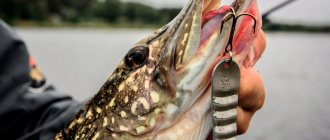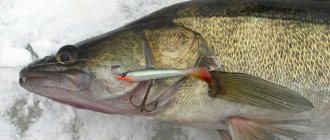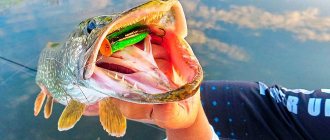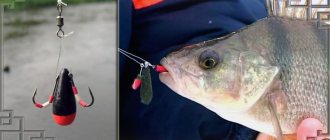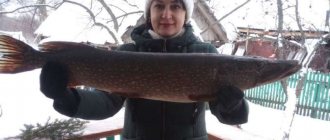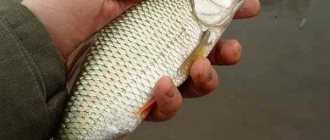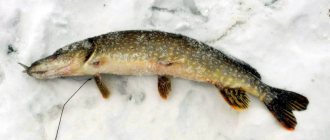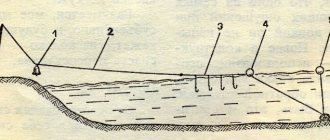When to catch pike with a balance beam
It is believed that pike is always active on the first ice. However, there are times when a toothy predator refuses to take the bait and there is no way to force it. And the capricious weather is to blame. When going fishing you should consider the following points:
- fluctuations in atmospheric pressure negatively affect the activity of pike;
- if the winter is warm, then throughout the winter high activity of the toothed predator is possible;
- cloudy weather is better suited for winter pike fishing on a balance beam;
- light snowfall, no frost, slight south or southwest wind;
- on clear frosty days, pike is just as active, but much less;
- It’s better to go fishing while it’s still dark, so you can start fishing at dawn.
Read also about fishing on the first ice at:
- Perch
- Roach
Features of tactics and search
The tactics for catching pike on a balance beam, as when using spinners, is to search for promising places and catch them. In areas of large reservoirs, it is advisable to fish as large areas of water as possible, so we drill a lot of holes. 10, 20, 30 – how much strength and desire is enough. Holes are drilled according to various patterns - in a line, zigzag or square-cluster method at a distance of 5-7 meters, depending on the location. For example, near reed thickets, you need to drill along the cut of the vegetation, at a distance of 1-2 meters from it. In a shallow bay, the entire area is surveyed. It is advisable to drill around a separate submerged snag. At the beginning and end of winter, when the pike is active, there is no point in staying on one hole; 7-8 retrieves are enough. If there is no grip, we move on further.
Catching pike with a balance beam in the dead of winter is more scrupulous. The predator may not take it right away. She can swim up and just watch the bait play without grabbing it. The absence of a bite during this period does not mean the absence of fish somewhere nearby. Maybe now is simply not the time; the predator will come out later. Therefore, it makes sense to periodically return to the holes and check again later. When fishing for pike with a balance beam in January, a bite is often brought by changing the bait to a smaller one. At this time, it is better to use sluggish-playing balancers, without a steering tail, with a brush or twister (bladeless). Pike also reacts to jig fishing or sluggish swaying, and may not respond to a sweeping game at all. An article about pike in the wilderness.
Therefore, in the middle of winter, the right choice of location plays a decisive role. It can take a long time to select bait and game, but you need to be sure that pike are present in this place. It is worth focusing on deeper places than in summer - drops, edges, exits from pits, areas with underwater vegetation, anomalies and deviations of the bottom topography.
driftwood
Catching pike on a balance beam in winter in snags - first of all (if there are any). The predator will stand right here. But when fishing like this you need to be careful, otherwise you can leave your entire supply of bait in the underwater wilds. You need to fish near or above snags. Using an echo sounder or camera can help determine fishing points. A good place is a solid massif of snags. In this case, it is important to determine the depth of the water layer where the snags end and fish above them. The branches can go down to great depths; in order to lure the pike out of there, the rocking method is used. To do this, a large bait is lowered into the hole with a sweeping game, several powerful tosses are made to create strong vibrations that attract a predator from afar. Then the bait is changed to a smaller one, five or seven, and the pike game itself is carried out, smooth and slow.
During periods of activity and hunger, pike takes whatever it wants. The main tactic is search and movement. You need to go to as many places as possible. In the middle of winter, dancing with a tambourine on ice is required. But with a skillful approach, even on days unfavorable for biting, you can get several pike tails from under the ice.
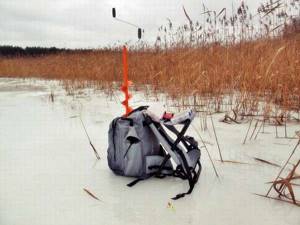
Small and large bodies of water
Searching for pike with a balance beam on small rivers is easier than on vast reservoirs. Promising places can be seen immediately by coastal landmarks - bushes, reeds, entrances and exits from holes, trees that have fallen into the water, deep places with overhanging vegetation, bays, areas where the reverse current enters the forward one.
On lakes and reservoirs you need to navigate by the bottom topography. At the beginning of winter and during the last ice, you need to explore summer places - shallow waters, grassy thickets and the entire coastal area. In the middle of winter, the toothy one stands deeper - on flooded riverbeds, near the mouths of rivers and streams, on underwater ridges, navels and other disturbances in the relief.

Tackle for catching pike on a balance beam
Fishing for pike in winter on a balance beam should be carried out with high-quality tackle:
- As a fishing rod, you can take a shortened version of a spinning rod, or use an original plastic fishing rod. It will be convenient to use a handle made of non-thermal conductive material. The length of the whip can be from 20 to 40 cm. The longer this element of the tackle, the easier it will be to absorb pike blows.
- Most fishing rods are already equipped with an inertial reel. Otherwise, you can use a baitcasting reel. There are special models of multipliers for winter fishing. Such reels are equipped with a friction brake, which makes it much easier to catch a predator.
- Whether to use fishing line or braid is a controversial issue. The fishing line does not freeze as much as braid, so most anglers use it. It is advisable to use fluorocarbon fishing line - it is more resistant to abrasion on the edge of the ice. The optimal diameter of the fishing line will be 0.25-0.3 mm. Braided wire is a stronger option, the reliability of which is beyond doubt. You just can’t use it in cold weather. When fishing regularly, it is necessary to cut off the used piece, as its strength is lost due to friction against the edges of the hole.
- A leash is mandatory when fishing for pike. It is convenient to use leads from a guitar string numbered 1 or 2. This element of the equipment should not be deformed or bent, otherwise the play of the balancer will be disrupted.
Equipment
Balancers for pike fishing in winter require a certain approach in equipment. The main point is the thickness of the fishing line and the attachment point to it. On thick fishing line, the balancer will not play correctly. A thin seasoned predator will easily tear off, especially in snags. The best option is a diameter of about 25-0.3 mm. The equipment of a fishing rod with a balancer for pike must be adjusted. For heavy baits, thicker fishing line is used, for small ones - thinner. You need a fishing rod that is strong enough, rigid, but elastic (for normal hooking). At the same time, the angler must feel the weight of the bait and its action. Tackle for catching pike on a balancer in winter is adjusted depending on the fishing conditions. In snags, a rough, strong fishing rod with a thick fishing line will come in handy - if you catch a fish, you must immediately pull it onto the ice. To catch passive fish in the wilderness with small baits, you will need a light, elegant fishing rod with a nod so that you can notice weak bites or bites on the rise and tosses. Fishing conditions determine everything: both technique and equipment.
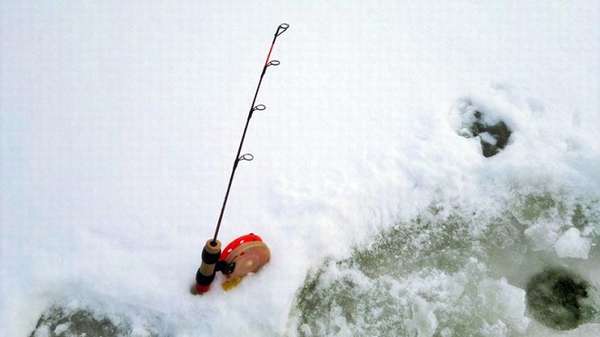
Separately, we need to touch upon the issue of equipping a winter fishing rod for pike with a balancer. The main problem is the leash. A thick metal leash reduces the number of grips by an order of magnitude. At the same time, its absence leads to the pike cutting off the bait. Most anglers still use balance leashes on pike, since some baits are expensive and cannot be treated as consumables. During the first ice and during periods of pre-spring activity, you can use ordinary leashes made of string, titanium, and tungsten. In the wilderness, the following options come to the rescue:
- A leash made of thin braid 0.12-0.15, single or double, which is replaced after each catch. When playing, you should not give any slack so that the thread passing through the mouth does not once again crawl over the teeth of the predator.
- Three strand clear fluorocarbon braid, thick fluorocarbon or leader material (clear). It is winter fluor that is required - its outer layers are more resistant to damage than ordinary monofilament.
- Refusal of the leash (the bait clings directly to the fishing line). This is possible if in this particular place at a given time the pike does not take the bait completely, but with the edges of its mouth. This may be known personally or from the words of other anglers. Suitable only for large sizes, at least 5 centimeters. The toothy fish almost always swallows smaller baits completely.
Fishing for pike with a balance beam from ice is not such an easy task. Some completely unobvious little thing can make fishing easier, for example, a thinner leash or a red tassel on the tee. Or maybe some specific shaking of the bait during the pause after the toss. A certain vision and intuition comes only with practical experience.
So what fishing line should you use for a balancer when fishing for pike in winter? The best option is high-quality winter fluorocarbon about 25-0.4 mm with low memory, low elongation and resistant to damage from ice, snags and underwater debris. The process of choosing a fishing line for catching pike on a balance beam in winter is a matter of practice. Sometimes you have to go through dozens of options in today's market until you find the right one. Article about choosing fishing line for balancers: https://berlogakarelia.ru/snasti/blesnenie/leska-dlya-balansira
You can make a rod for a balancer for pike yourself from a whip or the tip of a feeder. Of course, the best option is a special winter fishing rod for trolling. In the simplest version, reels are suitable for storing a supply of fishing line. The ideal tackle should be equipped with a reel with a friction brake (ratchet). You can use special winter reels, multipliers or inertia-free reels. An article about gear for a winter balance beam.
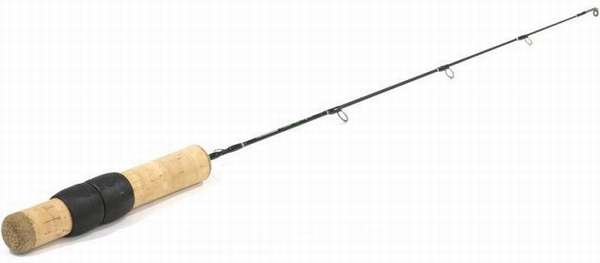
How to choose a balancer for pike
Today's market presents the modern fisherman with a wide range of balancers. What you need to consider when selecting balancers for pike, read below:
- The size of the balancer should be in the range from 5 to 10 cm. Lures from 5 to 7 cm in size can be considered universal - they also catch perch well. The most preferred size for pike is 7 to 9 cm.
- Tees on pike balancers must be numbered from 4 to 6 according to the international classification. The tee can be supplemented with a drop of weight so that when casting it does not overlap the fishing line.
- Popular pike colors include perch imitation, white with red head, and a variety of fancy colors.
- The shape of the balancer does not have a significant size, but it is believed that the wider belly of the bait contributes to excellent gliding properties.
- The balancer hooks should be large enough with a large offset - the tip of the hook should not extend into the bait area.
Read also: The best balancers for pike
Fishing technique
The correct technique for catching pike on a balance beam is a fundamental point. The wrong game can scare away and alert the predator. Without the necessary wiring, the most catchy winter pike balancer is a useless piece of hardware. Let's look at how to properly catch pike with a balance beam in winter.
The technique of catching passive and active fish is radically different. Active play - standard tosses and pauses.
- We lower the tackle to the bottom.
- Raise it by 7-15 centimeters.
- We do tosses and pauses. The pause length ranges from a few seconds to tens, depending on the bait model. The tackle must come to a complete stop before making another throw.
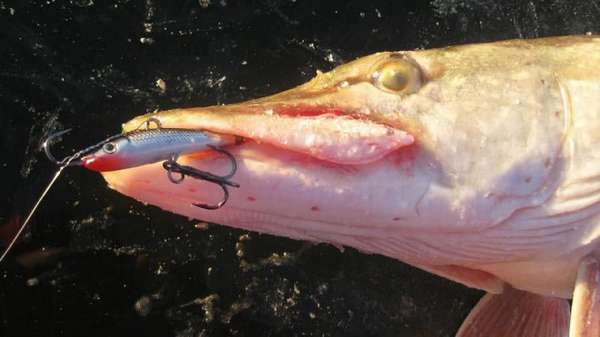
The bite can be either obvious (in the hand) or weak (poke, hanging weight, raising or lowering the nod). If the bites are weak and there is no hook, you need to reduce the size of the bait, slow down or change the game.
Most often you have to invent something. And even more so during periods of low winter. The most important thing is to avoid random and unnecessary sudden movements in the hole. The bait is lowered into the hole. The game is being played. No unnecessary movements or twitching. Sharp jerks will scare away the fish. For passive fish, throws should be made shorter, smoother, and pauses should be long. Sometimes the toothy one reacts to a bait simply hanging in the water (in fact, it is not completely motionless, but oscillates slightly due to the trembling of the hand and the weak movement of the water). Sometimes the predator is provoked by jig-like movements and twitching while paused. It is impossible to fully describe how to play a pike with a balance beam. Over time, each angler develops his own fishing nuances, which he may not even be aware of. This is the result of extensive experience and frequent practice with the tackle.
Typical mistakes when fishing
Winter fishing for pike perch using a balance beam is very often accompanied by annoying disappointments, which may be associated with the following points:
- The balancer must be properly tied.
- It is advisable to use a fastener at the place where the balancer is attached. So it’s better to change baits in the cold.
- The sharpness of the hooks should be at the highest level.
- The line must match its breaking load. This indicator must be checked experimentally, because incorrect data may be indicated on the packaging of the fishing line.
- It is necessary to qualitatively fish the entire hole on all layers; sometimes pike perch bites in the most unpredictable place and at the most unexpected moment.
- Any wiring with a balancer must begin with it touching the bottom.
- When catching pike perch, strong and sweeping strokes are not practiced - such imitation is of little interest to pike perch.
Therefore, all these options must be given sufficient attention so as not to miss your trophy.

So, a balancer for winter fishing for pike perch is one of the possible options for getting a cautious fanged predator out of the hole in winter. Moreover, there are no special requirements for gear and skill in such fishing. Even a beginner can easily take the necessary accessories and learn the basics of catching trophies. Moreover, compared to other winter fishing methods - bottom fishing and trolling - fishing with balance beams is more exciting and sporty. The balancer is more accessible on today's market - any model, weight and color can be chosen without problems. But the issue with spinners is much more complicated - the range of pike perch spinners is not large. Therefore, balancers for pike perch in winter are one of the most relevant types of fishing of the future.
